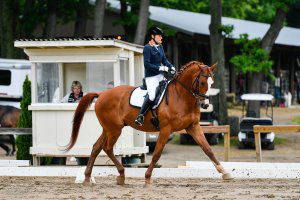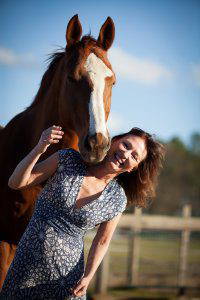If you’ve seen this video, you know how I ended up on the ground. What I mean is how did I end up in Wellington, Florida, competing internationally in para dressage, a sport I didn’t know existed 4 years ago? And competitive enough to be named as alternate to the U.S. team competition for that same weekend?
If you’re reading this, you know horse obsession doesn’t care if you live in New York City with nowhere to put a horse even if your family could afford one.
Horse obsession doesn’t care if you were born with disabilities, either.
I died at birth. No, really. I don’t have a birth certificate. My mother had what was then called toxemia but is now called gestational diabetes. Doctors determined I had no heartbeat, so they focused on saving my mom. In doing so, they pulled me out and handed me to a nurse who took me to the morgue. Morgue tables are frigid, so when I hit that cold table, I gasped. Over the next weeks, my heart stopped again and again but I was as stubborn then as now, I guess, because by week 3, they could begin to determine the extent of my disabilities.
Born with Erb’s Palsy, my left arm is about 6 inches shorter than my right; I can’t lift or straighten it, and I have little feeling there. The hand faced backward until surgery at 7-years-old to cut and turn it around. One side of my brain was crushed in the birth process, so I also have neurological problems affecting control of my lower legs, balance, and strength.
In my 50’s, an MRI discovered other damage to my brain. It’s strange. My verbal and math skills were always fine, but there are parts of my brain that are literally dead spots creating cognitive issues like memory and spacial reasoning problems (I’ll explain this in a later post). I learned to compensate – find alternate ways – for almost all of it. I make lists, lots of lists. I still use a GPS to my trainer’s barn. And as a young girl, when I desperately wanted to live my dream of riding horses, I joined the Girl Scouts, and stayed a scout through graduation.
But I never viewed myself as disabled. Neither do most people who know me.
I earned a scholarship to the University of South Carolina, graduating with both BS and BA degrees. Business, marriage and children filled my life, but I still took every opportunity to ride. Every opportunity. At 37, six months after my last child was born, I bought my first horse, an Arabian. I had 3 in six months. My three daughters and I are all equestrians. Endurance, hunter pleasure, western, native Arabian costume, saddle seat, trail – even sidesaddle. Our time spent together riding horses is the mother-daughter experience that every horse-loving mother hopes to have. We did it all and loved every minute, but I was never truly competitive in the show ring. I’d drop my reins, lose my stirrup, or fall off, but I still loved showing.
A few years ago, our first horses retired to pasture. I bought a three-year-old Arabian gelding, Wrigley, to start the fun again. Little did I know that this horse would set me on a new equestrian adventure. Dressage was definitely off my radar. When Melanie Mitchell, my incredible dressage trainer, first saw my new gelding’s gaits, she said “He is a freak of nature – an Arabian dressage pony.” I explained that I didn’t ride dressage. “You will,” she said. She was right. In June of 2013, I showed my first Novice Para Tests on him. Simply put, I was hooked.
When I began showing dressage, it became apparent that I could no longer hide or ignore my disabilities. Dressage demands finesse, and I had none with normal tack. Melanie encouraged me to consider my para-equestrian options; it was news to me that options existed. I started by using looped reins in main ring Arabian classes.
In December 2013, Melanie suggested a para dressage clinic across the country in California. That clinic, with a borrowed upper level horse, showed me I could be truly competitive with the right partner. After that, it was a maelstrom of classification, horse passports, para classes, Gladstone, Wellington, and much, much more. At times, quite overwhelming.
When my girls grew into lives of their own and moved all across North America, I sold my business of 22 years and divorced, devoting myself to reaching new goals. I continued with para classes but also showed able-bodied classes with Wrigley and a leased school horse with whom I earned my Bronze medal. To reach even higher though, I needed an international quality partner.
After searching for almost a year, I saw a video of Quaterjack, aka Snickers. He was the first and last horse of many I tried. I knew he was THE one as soon as I picked up the reins. We connected in a way I’d never done with any other horse. He took in my disabilities and instead of taking advantage of them, he partnered with me. His huge gaits and loft were alien to me, but he dialed them back and only gave me as much as I could handle. He still does that. (More about this special horse and our many successes, para and able-bodied, in later blog posts!)
Posting the Halting at C video gave me a voice to help educate and inform a worldwide audience about para-equestrian sports. I’ve been considering what I want to say with this blog going forward. For starters, I believe there’s almost always another way. You need an open mind, and time. Try once, surprise yourself. Try again, surprise others.
It’s been an interesting trek, so far. Our next chance to shine is the Test Event for WEG in April. Come along with me. I promise to write from my heart.
Pam Hardin, Grade IV Para-Equestrian Dressage Athlete
Search
Recent Articles
- The Good, The Bad and The Ugly of Coaching
- Does your horse need more energy, especially when competing?
- Grade 1 International Para Dressage Rider Di Green- Why Lexi Needed a Year Off
- Louise Blanch – Driving Towards New Horizons with the Continued Support of the Para Equestrian Foundation.
- Kissing Spine – Prevention or Cure?
Categories
- Advice Hub
- Athlete
- Carriage Driving
- Dentistry
- Dressage
- Endurance
- Eventing
- Farrier
- Featured
- Featured Horse Ads
- Featured Posts
- Horse Racing
- Horse's Mouth
- Horseball
- Hunting
- Le Trec
- Leisure Riders
- Mounted Games
- Nutrition
- Polo
- Polocrosse
- Reining
- Rescue & Rehabilitation
- Show Jumping
- Showing
- Tack Room
- Team Chasing
- The Pony Club
- Therapy
- Training
- Vaulting
- Veterinary






